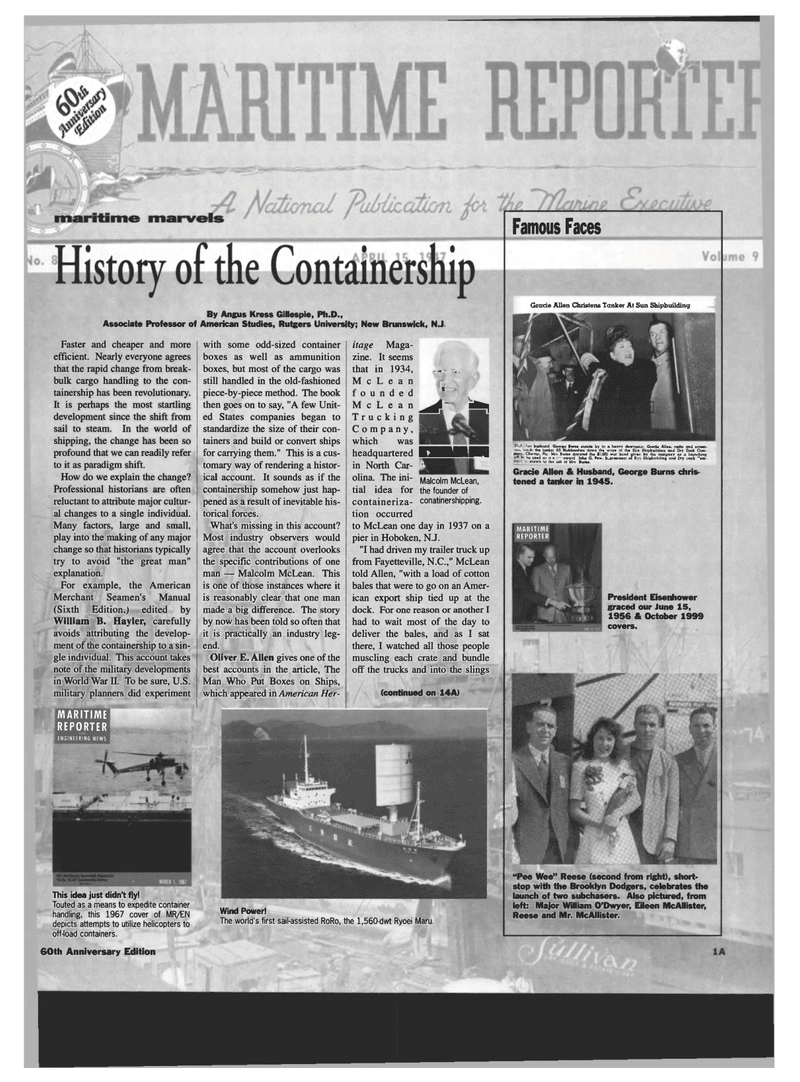
Page 41: of Maritime Reporter Magazine (October 1999)
Read this page in Pdf, Flash or Html5 edition of October 1999 Maritime Reporter Magazine
MARITIME
REPORTER
MARITIME
REPORTER
ENGINEERING NEWS
Famous Faces
Grade Allen Christens Tanker At Sun Shipbuilding
By Angus Kress Gillespie, Ph.D.,
Associate Professor of American Studies, Rutgers University; New Brunswick, N.J.
Faster and cheaper and more efficient. Nearly everyone agrees that the rapid change from break- bulk cargo handling to the con- tainership has been revolutionary.
It is perhaps the most startling development since the shift from sail to steam. In the world of shipping, the change has been so profound that we can readily refer to it as paradigm shift.
How do we explain the change?
Professional historians are often reluctant to attribute major cultur- al changes to a single individual.
Many factors, large and small, play into the making of any major change so that historians typically try to avoid "the great man" explanation.
For example, the American
Merchant Seamen's Manual (Sixth Edition.) edited by
William B. Hayler, carefully avoids attributing the develop- ment of the containership to a sin- gle individual. This account takes note of the military developments in World War II. To be sure, U.S. military planners did experiment with some odd-sized container boxes as well as ammunition boxes, but most of the cargo was still handled in the old-fashioned piece-by-piece method. The book then goes on to say, "A few Unit- ed States companies began to standardize the size of their con- tainers and build or convert ships for carrying them." This is a cus- tomary way of rendering a histor- ical account. It sounds as if the containership somehow just hap- pened as a result of inevitable his- torical forces.
What's missing in this account?
Most industry observers would agree that the account overlooks the specific contributions of one man — Malcolm McLean. This is one of those instances where it is reasonably clear that one man made a big difference. The story by now has been told so often that it is practically an industry leg- end.
Oliver E. Allen gives one of the best accounts in the article, The
Man Who Put Boxes on Ships, which appeared in American Her- itage Maga- zine. It seems that in 1934, . .. .
McLean | founded
McLean ^^t" afekj
Trucking
Company, which was headquartered BH in North Car- " olina. Theini- Malcolm McLean, tial idea for the founder of containeriza- conatinershipping. tion occurred to McLean one day in 1937 on a pier in Hoboken, N.J. "I had driven my trailer truck up from Fayetteville, N.C.," McLean told Allen, "with a load of cotton bales that were to go on an Amer- ican export ship tied up at the dock. For one reason or another I had to wait most of the day to deliver the bales, and as I sat there, I watched all those people muscling each crate and bundle off the trucks and into the slings ®?hi3f? her husband. Georga Bams stands by in o heavy downpour. Gracie Alien, radio and screex. ste:, sends the ton ice; 3F Hubbatdton down th« -ways af I ho Son. ShipbuiJdins acd Dry Dock. Ccsn-
JSpxy, Chester, Pa.- Mrs Burns donated the $1,030 war bond giver, by the company as a launching MM US«d
Gracie Allen & Husband, George Burns chris- tened a tanker in 1945.
President Eisenhower graced our June 15, 1956 & October 1999 covers. (continued on 14A) "Pee Wee" Reese (second from right), short- stop with the Brooklyn Dodgers, celebrates the launch of two subchasers. Also pictured, from left: Major William O'Dwyer, Eileen McAllister,
Reese and Mr. McAllister.
This idea just didn't fly!
Touted as a means to expedite container handling, this 1967 cover of MR/EN depicts attempts to utilize helicopters to
Wind Power!
The world's first sail-assisted RoRo, the 1,560-dwt Ryoei Maru, off-load containers. 16A 60th Anniversary Edition

 40
40

 42
42
